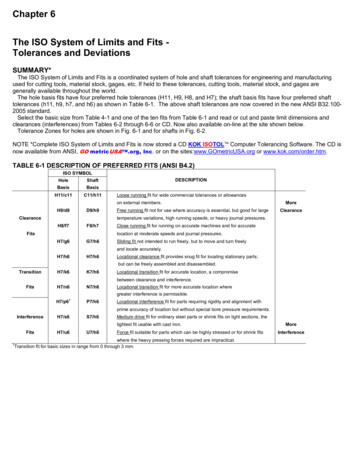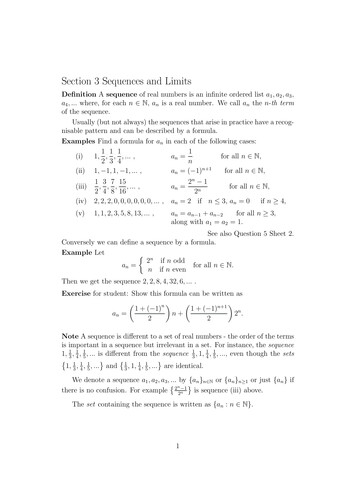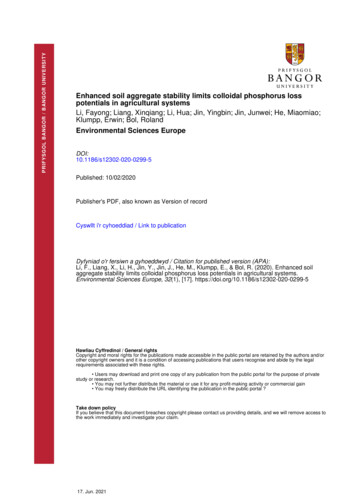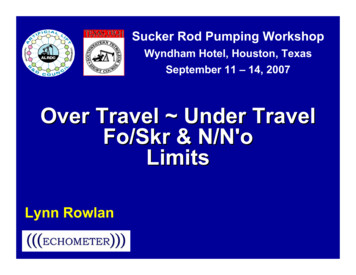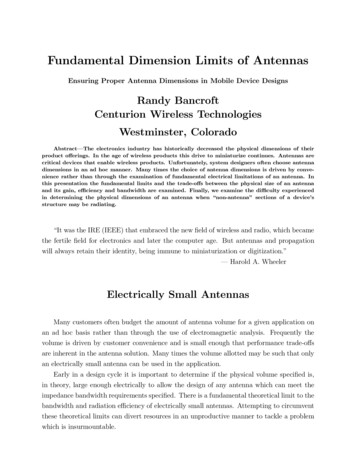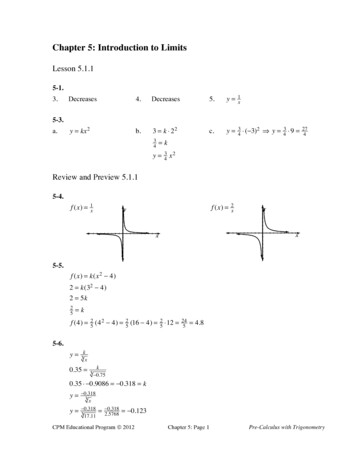
Transcription
Chapter 5: Introduction to LimitsLesson 5.1.15-1.3.Decreases4.Decreases5.y 1xy kx 2b.3 k ! 22c.y 345-3.a.34! ("3)2 # y 34!9 274 ky 34x2Review and Preview 5.1.15-4.f (x) f (x) 1x2x5-5.f (x) k(x 2 ! 4)2 k(32 ! 4)2 5k25 kf (4) 25(4 2 ! 4) 25(16 ! 4) 25 "12 245 4.85-6.y k3x0.35 k3 !0.750.35 " !0.9086 !0.318 ky y !0.3183x!0.3183 17.11 !0.3182.5768 !0.123CPM Educational Program 2012Chapter 5: Page 1Pre-Calculus with Trigonometry
5-7.a.3( )2cos ( ! "3 ) cos "3 12tan ( ! "3 ) ! tan "3 ! 13 ! 311csc ( ! "3 ) ! !3sin(! " 3)sin ! "3 ! sin "3 !b.cos ( !3" ) cos 3" !1tan ( !3" ) ! tan 3" !0 023 !11 # und.sin(!3" ) 011sec ( !3" ) !1cos(!3" ) !111cot ( !3" ) # und.tan(!3" ) 0csc ( !3" ) 2 332( )sec ! "3 ( )1 ( )cos !"31 !tan(! " 3)cot ! "3 11213 2 !sin ( !3" ) ! sin 3" !0 0335-8.Length of interval 3 ! (!1) 433" h(x)dx "!1f (x)dx 5 # 4 17 20 37!15-9.Volume of Florida grapefruit 43! " r3Diameter of Texas grapefruit 2r where r diameter of Florida grapefruit.Volume of Texas grapefruit 43! ( 2r ) 43 ! 8r 3 8 "3( 43 ! " r 3 )# Texas grapefruit is 8 times as big as Florida grapefruit, but only costs 7 times as much,thus making it the better deal.5-10.a.7!6, 116!b.5!6, 116!5-11.a.(x 2)(x 2)(x 2)(x 2)b.(x!2)(x! 3)(x!2)(x!2)c.2(x y)(x! y)(x y) (x 2)(x 2) (x 2)2 x ! "2x! 3x!2x"2 2 ( x ! y)x " !y5-12.y kx a!!!!!x length of tube!!!!!a cross-section area of tubeCPM Educational Program 2012Chapter 5: Page 2Pre-Calculus with Trigonometry
Lesson 5.1.25-13.Numerator and denominate must be polynomials.x and x are not polynomials.5-14.a.2017 1 173 14 5 14 77b.197b.f (x) 57 2575-15.a.f (x) 1x1x 2 3This is the graph of f (x) shifted2 units to the left and 3 units up.5-16.g(x) 1 3x!1a.b.b.h(x) 2 x!5x! 3 2(x! 3) 1x! 3 2(x! 3)x! 3 1x! 3 2 Graph1x! 35-17.It is the graph of y 1xshifted up 2 units and right 3 units. y 1x! 3 25-18.Multiply the numerator and denominator by xy 2 .5-19.a.x2x2!x "1y2 y"2x y"1 xy2y y!xy2 x 2 yy"1 x 3 y2CPM Educational Program 2012 xy 3 x 2 y21 x 3 y 3b.Chapter 5: Page 3y3y3!x 2 y 3 y"3y"3 x x 2 y6 11 xy 3Pre-Calculus with Trigonometry
5-20.a.u c.!#"1x x 2 y2xy2 xy2 &%'2y2xy2! #" x2xy2xy2x 2 y2 x 2 y2xy22 &% (xy2 )2(x 2 y2 )2 b.xy22x y2b.u ab !1 a !2b x2 y4(x 2 y2 )25-21.a.u x y !1 x u !1 c.1u 1xy 1 y1y u ab !1 a !2b u !1 1u2xy 1y yxy 1ab 12" a 3 b 2 % # 2 '&a bu !1 ba2 (1u a 3 b 2a2 bab ba213a b 2 a 2 b a2 b3a b 2a 3 b 2a2 b24 2a2 b 3a b 2 232a b(a b ) )Review and Preview 5.1.25-22.Example: Vertical asymptote at x !7 " y 1x 7Horizontal asymptote at x 5 " y 1x 7 55-23.2 x(3x!1)(3x!1)!1(3x!1)(3x!1)3 (3x!1) 6 x 2 !2 x! 3x 1 3(3x!1) 6 x 2 !5 x 4(3x!1)5-24.11!6, " !3a.Any angle in the 4th quadrant will satisfy this. Examples:b.sin x !c.Any angle in the 3rd quadrant will satisfy this. Examples:d.e.Approximately 67!Not possible, it does not satisfy the Fundamental Pythagorean Identity.cos2 ! sin 2 ! 112" x 7#6, 116#7!6, 54!(0.9)2 (0.8)2 0.81 0.64 1.45 " 1CPM Educational Program 2012Chapter 5: Page 4Pre-Calculus with Trigonometry
5-25.a.y 1 kx2 ! 3k!2f (x) b.f (!3) !2 ky f (2) !2x2 ! 3!2x2 ! 3!2(!3)2 ! 3!222 ! 3 !26 !21 ! 13 !2!2!2 !2 " ! 4 8 !11( 12 ) (1 2)!22 ! 3 1 4!12( 11 ) 1144!2!2a2!2a 2f ( ! 1a ) !2"! ()(!1 a)2 ! 31 a 2 ! 3a 2 a 21! 3a 21! 3a 2f5-26.a.kd2b.A(d) sec ! "2b.cot ! 3A(d) k(3d )2 k9d 2 19 !kd2It decreases19as much.5-27.a.1cos ! "21 "2 cos !"12 cos !! 2#3, 43#1tan! 31 3 tan !13 tan !! "6, 76"5-28.a.3 x 3 4x 3 4x 4 x 3 3 4x 4x23 4x 4 " 2x ! 1 x 2 2x 3 ! 1 x 2x32x 3 ! 1 2x 4 ! xb.1 x 2 y2 1 x 2 y2 x 2 1 x 2 y2y2y2 x 2 y 4 " x 2 ! 1 y2 x 2 y2 ! 1 y2x2x 2 y2 ! 1 x 4 y2 ! x 2c.1 x 4 y 2 1 x 3 y 1 xy x 4 y 2 1 xy x 31 xy 2 4 2 " 2 3 2331 x !1 xx !1 xx y x ! 1 x y ! xy 2CPM Educational Program 2012Chapter 5: Page 5Pre-Calculus with Trigonometry
Lesson 5.1.35-29.See graph at right.The x-intercept of the first function is the x-value of thevertical asymptote of the second (x 3) .5-30.a.See graph at right.x 2, x !2b.Yes, y 0c.x !2 or x 2d.!2 x 25-31.f (x) sec(x)!See graph at right.a.(2! n, 1) and (! 2! n, " 1), n an integer .b.x!c.Range: cos x ! ["1, 1]; sec x ! y # 1 or y "1"2 " n, n an integer5-32.1f (x)See graph at right.5-33.See graph below.Cosecant: Domain: x ! " n , n an integerRange: y ! "1 or y # 1CPM Educational Program 2012Chapter 5: Page 6Pre-Calculus with Trigonometry
Review and Preview 5.1.35-34.T 0.0725Pa.b.k 0.07255-35.a.b.y 2f (100) f (1000) f (10000) 2(100) 3203 2.0099 101100 12(1000) 32003 2.0010 10011000 12(10000) 320003 2.0001 1000110000 1c.Yes, since x ! "1, x "1 is the vertical asymptote.d.f (x) 5-36.2 x 3x 1 2 1x 1This is the graph of1x, shifted one unit left and two units up .Possible answer: g(x) (x 1)(x ! 2)5-37.34x25-38.c 1 25 ! 10c c 2Check0 c 2 ! 11c 240 (c ! 8)(c ! 3)c 3, 83 1 5 ! 3 28 1 3 " 5 ! 8 !3Solution : c 35-39.a(x) 1 , b(x) 1h(x)f (x)5-40.a.d (5 ! (!2))2 (!2 ! 5)2b.d 7 2 7 2 98 7 2!2!5 !7 !1slope m 5!(!2)7Point-Slope Form:y ! 5 !(x ! (!2))y ! 5 !(x 2)Slope-Intercept Form:CPM Educational Program 2012ORy ! (!2) !(x ! 5)y 2 !(x ! 5)y 2 !(x ! 5)y 2 !x 5y !x 3Chapter 5: Page 7Pre-Calculus with Trigonometry
Lesson 5.2.15-41.f (x) See graph at right.1x!2 3lim f (x) 3x!"5-42.a.He thinks that he will get to 3.b.She thinks that she will get to 1.5-43.a.She thinks she is getting infinitely far up.b. means approaching from the right. – means approaching from the left.lim f (x) 1 , lim f (x) 3c.x!3"x!3 5-44.a.b.c.d.e.lim f (x) "#lim f (x) "x!4 ( ) 0lim 3x!" x 3b.()lim 5x 4 "x!"c.( 9x ) 0lim #x!"lim sin x No limit.x!"sin x oscillates between –1 and 1, but does not approach any specific number.An example is f (x) cos x .2 x 4x 3 2(x 3)!2(x 3) !2x 3 2lim g(x) 2,!lim g(x) ",!lim g(x) #"x!"5-47.!1x!4 "5-46.a.g(x) b.2x! 4x!"5-45.a.f (x) See graph at right.lim f (x) #1x!#3#x!#3 x must approach ! from the left and must approach !" from the right, therefore we donot need extra notation. x cannot approach ! from the right.CPM Educational Program 2012Chapter 5: Page 8Pre-Calculus with Trigonometry
Review and Preview 5.2.15-48.See graph at right.lim f (x) 2 2 3 7x!25-49.In the first, the limit is approaching –2, and in the second, the limit is approaching 2 fromthe left side.5-50.As x ! " ,y kx2lim 12x!" x1x2gets smaller and smaller. 05-51.a.If u sin ! " u3 # 4uu2 3u 3 ! 4u 3u 2b.u 3 ! 3u 2 ! 4u 0u(u 2 ! 3u ! 4) 0u(u ! 4)(u 1) 0u !1, 0, 4But u sin " # 0So u !1, 4c.sin ! "1! 3#2orsin ! 4, !!!!!!!! sin ! 45-52.a.1635-53.a.S(r) kr 2b.b.3n 210n 2 !516! k " (2)216! 4kk 4!S(r) 4! " r 2SA S(3) 4! " 33 36!5-54.a.2CPM Educational Program 2012b.Chapter 5: Page 95.152Pre-Calculus with Trigonometry
Lesson 5.2.15-55.f.If the procedures are followed accurately, all the last acute angles should be very close to 60º.g.They should say 60º. Once this angle is reached, the obtuse angle will be 120º. This is, ofcourse, interesting since theoretically this angle is never reached. When it is bisected theresulting angle will equal 60º. Do not simply accept as justification that the patterncontinues.5-56.a.They are alternate interior angles.c.n1234567Measure of an2080506557.561.2559.3758e.!b.180! ! 20! 160!; a2 160 80!2d.60.000 is obtained by n 18.Students can repeat this process byusing the ANS key on theircalculator. Enter 20 and push Í.At the next line use (180 – Z)/2.Repeatedly hitting Í willgenerate the sequence.f.The measure approaches 60º.60.3125lim an 60x!"5-57.nAngle anMeasure of angle a1Error: 60 – angle M Educational Program 2012Chapter 5: Page 10Pre-Calculus with Trigonometry
Review and Preview 5.2.25-58.0 a 1a 1lim g(x)0!lim g(x)!0g(x) a xExampleSketchx! "x! "#5-59.f (x) 2 x ! 3See graph at right.lim (2 x # 3) " # 3 "x!"lim (2 x # 3) 0 # 3 #3x! #"5-60.The limit is 60; it will never actually equal 60 unless the original acute angle was 60º.5-61.a.S kpmb.60c.5-62.sin 60! 0.866 They are the same because 60! sin !3 0.866!3The score would be infinite.5-63.a.4 and 5 should be multiplied, not added. log 4 log 5 log 20b.Base should not change. log 3 7 log 3 7 log 3 49c.Log of a product is the SUM of the logs. log(4 ! 5) log 4 log 5d.No rule for log(4 5) .5-64.f (x) 1x!2! 3 , asymptotes at x 2 and y !3CPM Educational Program 2012Chapter 5: Page 11Pre-Calculus with Trigonometry
5-65.a.Closest that Jade can be is when sin ! "1 . ! d 25("1) 35 10 feet. Farthest awaythat Jade can be is when sin ! 1 . ! d 25(1) 35 60 feetb.( !15"t ) 350 25 sin ( !15"t )0 sin ( !15"t )sin #1 0 sin #1 ( sin ( !15"t ) )35 25 sin2! ( !15"t ) 3525 25 sin ( !15"t )sin #1 1 sin #1 ( sin ( !15"t ) )60 25 sinc.15 !"! 2 t ! "t15! "t 15"15 !15 7.52secondsSecond time 30 sec 7.5 sec 37.5 sec30! ! " tt 30 secondsd.5-66.a.x2 y3 1 x2 x 4 y3 1 x2 x 4 y3 1y3x 4 y6 y 3 ! 1 y3 x1 xy 3 y 3x21 xy 3 x 2 x 3 y 3b.1 x x21 x3 x 1 x3 x2 ! x1 x2 x 1 x3 x2x1 x3CPM Educational Program 2012Chapter 5: Page 12Pre-Calculus with Trigonometry
Lesson 5.2.35-67.a.He thinks the height will be y 2 .b.She thinks she will approach y 2 .c.# !x 2 4f (x) %& 2x ! 3x"3x 3Benny: lim f (x) 2 ;x!3"Bertha: lim f (x) 2x!3 lim f (x) 3x!1 5-68.Right- and left-hand limits must be equal for a limit to exist.5-69.a.c.x2 ! 2for x " 2%#b.i. !" , ii. ! , iii. 4, iv. 2f (x) 1!(x!2) 4forx 2&% 2It does not exist since the left hand limit and right hand limit are not the same.5-70.y# !x 2 4Example: f (x) %& 2x ! 3x"3f(x)x 3x5-71.a.lim f (x) 6.2, lim f (x) 6.2x! 3"b.x! 3 The limit exists since the limits as x approaches 3 from both the left and right sides areequal.Review and Preview 5.2.35-72.lim f (x) "2, lim f (x) "1x!3"x!3 lim f (x) does not exist as the limits from the left and right are not equal.x!35-73.f (x) !See graph at right.lim f (x) lim "x!"#x!"#1x" 3CPM Educational Program 20121x! 3 2 2 "0 2 2Chapter 5: Page 13Pre-Calculus with Trigonometry
5-74.See graph at right.5-75.limx!" x 21 0#45-76.1" x x !3 %x 1 x3x4 1 x3 x4 1 x2x4 1 ( # x !2 x !1 '&1 x2 1 x 1 x x2x3 1 x x x25-77.42b6 a, 15 15 42b 3 ,b 3 51442 ! b 9b65 b314" 0.709, a 42( )3 5146" 329.285-78.a.Possible estimate: lim g(x) " 0.42062x!1b.See graph at right.limit 0.420619845-79.a.b.See graph at right.lim x 2 " 9 0x!312 "9 xx!3lim #c.12 "9"xx!3lim "#d.12x"9x!3limLimit does not exist as left and right limits are not equal.CPM Educational Program 2012Chapter 5: Page 14Pre-Calculus with Trigonometry
Lesson 5.2.45-80.a.Yes, the limit exists, since the limit from the left and right are equal. lim g(x) 2x!3lim h(x) 2b.x!3c.d.h(3) 3No, the limit is the number f(x) approaches as x gets closer and closer to a.5-81.a.No, f(–3) and the limit do not exist.c.No, limit f(2).5-82.a.b.yb.d.ContinuousNo, f(4) does not exist.c.yxxaayxa5-83.a.x!0b.See graph at right.lim sin x 0, lim x 0c.x!0d.x!0The numerator and denominator of f(x) are both approaching 0.lim sinx x 1x!05-84.n! , n " 0a.b.c.f (x) sinx x oscillates as x ! " but gets closer to y 0 .The line y 0 IS a horizontal asymptote.d.sin xx!0 xlim 1CPM Educational Program 2012Chapter 5: Page 15Pre-Calculus with Trigonometry
Review and Preview 5.2.45-85.See graph at right.1 1x " !1, 2f (x)3x ! 3x!2Vertical Asymptotes of f (x) # x !1, x 25-86.lim xx!3 x 2 1 332 13 105-87.sin xx!" 2 xlim sin " 2" 2 1" 2 2"5-88.k10Area of cross-section !x 10!hk(10 ! h) 10xk(10!h)10 x()k(10"h) 210! 100k 2 (10 " h)2(radius of cross-section)5-89.a.cos 60! c.sin3!23!4 2212b.sin "1d.cos 90! 0CPM Educational Program 2012Chapter 5: Page 16Pre-Calculus with Trigonometry
5-90.a.csc 2 x sec 2 x ! tan 2 x ! cot 2 x 2(csc 25-91.5-92.a.x ! cot 2x) (sec 2x!!log 2 (AB) 4log 3 A " log 3 B 2!log 332 AB 169 A 16BB A 14.40 A ( AB ) ( B162 )16B243kw5!GPA10k 10k5! 3.51.52.16w5!GPA(x) 21 1 22 2tan 2log 2 A log 2 B 42 4 ABb.A sec x!1 1 cos x1!cos x 1 cos x203 sec x) sec xsec x 1!1!cos x1!cos2 xsec x!cos xsin 2 x1!cos2 xcos xsin 2 xsin 2 xcos xsin 2 x1cos x sec x sec x sec x sec x sec x( AB ) 2164 /3 12b. sec x!11!cos xk " k 2.1620 5 ! GPA 2.16(15)5!GPA2.16(15)20 1.62GPA 5 ! 1.62 ! 3.385-93.For x –2: 2(!2) a (!2)2 ! 2!4 a 2For x 3: 32 ! 2 !3 b7 !3 ba 6CPM Educational Program 201210 bChapter 5: Page 17Pre-Calculus with Trigonometry
Lesson 5.2.55-94.i.lim f (x) 0x!"#iv. lim f (x) no limitx!"25-95.ii.lim f (x) 2iii.x!"2 "vi. lim f (x) #"lim f (x) 3v.lim f (x) 3x!"2 x!"x!2lim f (x) 0 , lim f (x) # , lim f (x) # , lim f (x) does not existx!"#x!"4 "x!"4 x!"4lim f (x) 1 , lim f (x) "1 , lim f (x) 2 , lim f (x) does not existx!"15-96.x!1"x!1 x!1! are almost the same length and parallel. Therefore asWhen x is very small, AC and AB! change at similar rates.x changes, the lengths of AC and AB5-97.a.cos(x) approaches 1 while x approaches 0, so this isb.x approaches 0 while 2 x approaches 1, so this is1big1little big . little .5-98.a.x 0b.Both approach 0.c.See graph at right. lim f (x) 0x!0d.Yes, y 0 .Review and Preview 5.2.55-99.See graph at right.1 " cos xlim 0.5x!0x25-100.See graph at right.lim f (x) 3a.x!2 b.c.lim f (x) 1x!2 "lim f (x)x!2The limit does not exist because the limits fromthe left and the right sides are different.CPM Educational Program 2012Chapter 5: Page 18Pre-Calculus with Trigonometry
5-101.See graph at right.Example (one of many):5-102.a.Therefore th
CPM Educational Program 2012 Chapter 5: Page 1 Pre-Calculus with Trigonometry Chapter 5: Introduction to Limits Lesson 5.1.1 5-1. 3. Decreases 4. Decreases 5. y 1 .
